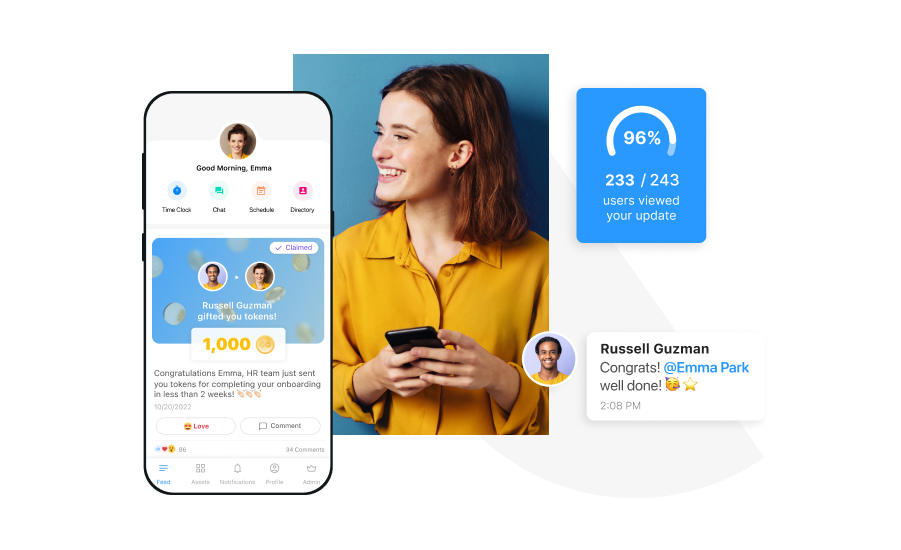Discover how mobile learning solutions are revolutionizing compliance training by making it more accessible, engaging, and effective for employees in today’s digital age.
Compliance training is high stakes. Employees need to learn the company policies and laws that can impact their roles. But traditionally, in-person learning has been a costly and sometimes challenging solution. Enter compliance-training apps.
These solutions have significantly changed how companies deliver training to their teams. So let’s take a closer look at what this tech is—and what it can do for your organization.
What Is Compliance Training?
Compliance training refers to the process of educating employees about laws, regulations, and industry standards that apply to their jobs and the organization as a whole.
The goal of compliance training is to ensure that employees understand their legal and ethical obligations and are aware of the potential consequences of noncompliance.
Compliance training may cover topics such as data privacy, anti-discrimination, anti-harassment, and anti-bribery laws, as well as industry-specific regulations such as HIPAA for healthcare organizations or FINRA for financial institutions.
Good compliance management and training should include the following topics:
- Safety training teaches workers how to stay safe on the job and avoid common industry hazards.
- Diversity, equity, and inclusion (DEI) training teaches team members how to make a workplace inviting for all workers.
- Company compliance training teaches employees any company rules they need to be aware of.
- Data security training teaches workers how to prevent data breaches of customer or company information.
- Sexual harassment training shows employees how to recognize and report harassment.
- HR compliance training teaches managers and HR professionals how to handle HR complaints.
- Ethics training helps organizations avoid corruption.
- Disaster training teaches employees what to do in case of a fire, natural disaster, or other serious events.
- 508 compliance training and disability awareness training. This shows the relevant employees how to make workplace resources accessible to employees living with a disability.
- Risk management helps teams identify and reduce safety risks in the workplace.
- Workplace violence training teaches workers how to stay safe if violence occurs.
- Workplace discrimination training can help workplaces avoid wrongful termination and other lawsuits.
- Environmental training. This teaches teams how to stay compliant with EPA (Environmental Protection Agency) rules and other relevant regulations.
In many industries and states, compliance training is mandatory. For example, healthcare workers may be required to learn the Health Insurance Portability and Accountability Act 2003 (HIPAA) and other relevant rules.
Even when it’s not required by law, compliance training is essential. It ensures employees are aware of workplace policies, and state and federal laws and regulations. This can prevent an organization from receiving penalties and fines. It can even reduce the risk of workplace injuries and company losses.
Compliance training also helps protect a company’s reputation. Imagine what would happen if a worker transferred customer files to a personal computer and those files were hacked. The data breach could make the news. Trained workers are less likely to make these kinds of mistakes, which helps to protect your whole organization.
While compliance training is important, it can also have some potential drawbacks. In-person training can be expensive because you need to bring in an experienced instructor. Getting employees’ schedules to align so everyone can be in the same room is also a challenge. This is particularly difficult if you have teams of deskless workers with different shifts.
For many workers, in-person training is like being back in school. It can be difficult to focus on compliance for hours at a time. Often, in-person training means a lecture format, and it can be hard for workers to retain complex information shared that way.
Tech and apps are changing the learning landscape by tackling some of these challenges.
Download your FREE guide on “6 Pillars for Improving Frontline Employee Retention” ⤵

How Have Compliance-Training Apps Helped Organizations?
Mobile compliance-training solutions have changed the game for organizations. Instead of asking everyone to meet in person, these solutions put the power of learning into an employee’s hands.
Let’s look at some of the ways these apps have changed compliance training.
They can pave the way for immersive learning
Mobile learning solutions can improve employee engagement in training. You can use video, audio, and text in online learning. This can be more exciting than learning through an in-person lecture.
With a chat feature, employees can ask questions about the training. They can even discuss compliance topics with their colleagues. Chatting about compliance takes compliance training out of the classroom and makes it part of the workday.
Some apps—such as Connecteam—also offer quizzes. Workers can check to see how well they’ve learned the subjects, and they can ask for more help if there’s something they’re struggling with.
They make learning accessible
Everyone learns differently. With an app, workers don’t have to rely on a schedule set by a teacher. They can study at their own pace and on their own time, reviewing concepts as many times as they need to.
Mobile compliance-training apps are also accessible because they’re on workers’ devices. If an employee cannot see text easily, they can increase the size of the text or even have their device dictate it. Workers can also generate transcripts for video or audio files.
Even employees in the field or working remotely can easily access compliance training with an app. When an employee has a few minutes, they can open their mobile device and start learning.
They offer new levels of customization
No two organizations have the same compliance-training needs. You may need to teach your team how to avoid workplace harassment, but you may also want to teach them your specific work behavior expectations.
Apps let you create your own training, so you can teach your workers exactly what they need to know. If that seems intimidating, don’t worry. Today’s apps have made it easy to drag and drop the files, photos, and videos that you already have into a training module. Tech has changed the game by making it simple to become your own training designer.
In an app like Connecteam, creating training is easy. Just name your class and start adding elements. You can add a resource library, PDFs, YouTube links, surveys, links, step-by-step instructions, and more. You can even include training material made available by state and federal agencies. Training can be delivered to everyone who needs it at the click of a button.
Another benefit of customization is that it’s easy to update your training. Has there been a change in your industry’s regulations? Have you rolled out a new product that requires compliance training? No problem. With customization, you can quickly create or update classes and assign them to your team as mandatory.
They boost ROI
Apps allow you to create many classes at a fraction of the cost of one in-person lesson. Since apps are customizable, you also get a better return on investment (ROI) because you get to teach exactly what your team needs to know. Leave out what’s irrelevant so your employees spend more time focusing on what matters.
They help meet current compliance needs
In 2008, following multiple corporate scandals involving ethics and regulatory violations, the Department of Justice (DOJ) released the Principles of Federal Prosecution of Business Organizations. In that publication, the DOJ told prosecutors to look at “whether a corporation’s compliance program is merely a ‘paper program’ or whether it was designed, implemented, reviewed, and revised, as appropriate, in an effective manner.”
The goal was to make it harder for companies to claim they had a compliance program when in fact that program was just another checkbox to mark off. With this guidance, some of the past ways of training just don’t work. Static classes and once-a-year lectures or workbooks can seem like “paper programs.”
Apps have changed the game by making compliance training a results-driven and ongoing learning process. With quizzes and with a way of tracking who has taken the program, an app proves your employees are actually taking part and learning.
Cost of Employee Turnover
Employee turnover rate
Total cost to onboard new employee
Total cost of lost productivity
Improve Workplace Compliance Today
Use Connecteam’s all-in-one platform to ensure compliance, streamline processes, and save time.
How Can You Make Mobile Compliance-Training Solutions Work at Your Company?
As new tech is rolled out and continues to change compliance training, it allows you to look for interactive, engaging solutions.
First, understand what you’re required to offer in training. Some states have specific compliance-training requirements for certain sectors. In Texas—for example—licensed childcare providers need training. Consult with an attorney or with your professional association to understand your requirements.
Then, use these best practices to get the best return on your investment.
- Make your training actionable. There’s a strong link between an employee’s satisfaction with training and the ability to understand how to apply what they’ve learned. A Gallup poll found that 84% of workers who rated their compliance training as excellent said they knew what to do when they saw unethical behavior at work. Make sure your training helps workers to take the right action.
- Reward your employees. Employee rewards make the learning process more fun and engaging. Look for an app that lets you hand out prizes to employees who complete training or who keep the discussion going on group chat.
- Make it fun. Turn learning into a game with rewards or levels. You can also make learning fun by using storytelling or real-life examples to keep your team interested.
- Simplify your learning. Break down training into bite-sized pieces. For example, compliance training about complex federal laws is easier when presented simply. Breaking training down also lets workers master one idea before moving on to the next.
- Use different learning tools. Use material like podcasts, videos, audio, files, eBooks, and more. Consider memes, pictures, graphs, slides, and anything else you need to make learning interesting.
- Buddy up. Create small study groups or assign “study buddies” to workers. These teams or partnerships can be used to discuss compliance in smaller settings. They can help close the gap between individual and group training by giving workers someone to talk to about what they’ve learned.
- Keep it interactive. Use a chat feature to start conversations about compliance by asking questions. Create training that lets workers act out or practice real-world scenarios in a chat so they can get feedback. Invite workers to share their questions and experiences online. The more employees interact with the information—instead of just consuming it—the more they can apply it to their job.
- Manage learning. An app that lets you see when workers have completed their training will help you manage your employee’s learning. Being able to see how often your training is accessed—and send reminders if needed—is also an important feature.
📚 This Might Interest You:
Read our guide to the best compliance management software to discover tools that streamline compliance training, track employee progress, and engage teams with interactive features. Implementing effective compliance software can make it easier for employees to complete required training, stay informed, and confidently apply compliance standards in their daily work.
Adapt your training where necessary
Adapt and update your training to keep it fresh. Remember to keep building on it too. You can do this in two ways.
Get feedback
Find out from workers what they think of your current compliance training and what they want to see in the future. Connecteam—for example—lets you send out surveys. It also lets you invite members of your team to offer feedback and even to help you put together lessons. With an app, learning becomes collaborative—rather than a top-down effort.
Combine training with other solutions.
Don’t just rely on training. A Gartner survey found that when companies use “embedded controls,” compliance violations declined by 58%.
Embedded controls are systems that direct employees to be compliant within their workflows. For example, Connecteam can help you create task checklists to make sure every job meets safety or industry regulations. This, coupled with training, can mean a better outcome than training alone.
Learning in the Palm of Your Hand
Mobile compliance-training apps take learning out of the classroom and puts it into your hands. You get more control, better ROI, and better engagement with apps. These apps can also make compliance training engaging—and even fun.
Apps can allow you to get better results and help your workers retain what they learn. Your employees have access to compliance training 24/7. They can always refer back to a lesson, review what they’ve learned, or use a chat feature to ask a follow-up question.
An app like Connecteam lets you reap the many benefits mobile learning has brought to the compliance-training space. It lets you customize, create, and update training as required, so you’re always delivering the programs your teams need.




